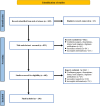Application of artificial intelligence in palliative care: a bibliometric analysis of research hotspots and trends
- PMID: 40470051
- PMCID: PMC12135806
- DOI: 10.3389/fmed.2025.1597195
Application of artificial intelligence in palliative care: a bibliometric analysis of research hotspots and trends
Abstract
Background: Palliative care, essential for improving quality of life in patients with serious illnesses, faces challenges such as resource limitations, workforce shortages, and the complexity of personalized care. AI's capabilities in data analysis and decision-making offer opportunities to optimize symptom management, predict end-of-life risks, and tailor care plans. However, existing research emphasizes isolated AI technologies rather than systematic evaluations of its developmental trajectory in palliative care, particularly through bibliometric and visualization studies. This gap obscures trends in technological applications, interdisciplinary collaboration pathways, and research hotspots, potentially hindering AI's practical innovation in the field.
Objective: This study employs bibliometric methods to analyze research trends in AI-driven palliative care, mapping knowledge structures and identifying hotspots to inform future advancements.
Methods: Data from the Web of Science Core Collection (inception to February 28, 2024) were analyzed using HistCite for bibliometric aggregation, VOSviewer for co-occurrence analysis, and CiteSpace for keyword trends.
Results: Among 246 publications from 45 countries, 615 institutions, and 1,456 authors, output surged notably between 2020 and 2024. The U.S. and the Journal of Pain and Symptom Management led contributions. Keyword analysis highlighted research foci on deep learning, neural networks, quality-of-life enhancement, survival prediction, AI model development, and clinical optimization. Emerging trends emphasize machine learning and holistic AI integration.
Conclusion: Despite the increasing number of related studies in recent years, the field remains in its early developmental stage, indicating vast potential for further research. Studies have shown that international collaboration, particularly between the United States and China, is crucial for enhancing global academic influence. Prominent institutions in the United States, such as Harvard Medical School and the University of Pennsylvania, have led research in this area, while the involvement of other countries, especially developing nations, still requires strengthening. Technological analyses reveal that machine learning, deep learning, and natural language processing are becoming increasingly significant in palliative care. Future research will focus on improving patient quality of life, personalized treatment, and disease prognosis prediction, with an emphasis on interdisciplinary collaboration and the integration of technology with clinical practice to foster the innovative development of artificial intelligence in palliative care.
Systematic review registration: https://osf.io/, identifier https://doi.org/10.17605/OSF.IO/YCHNQ.
Keywords: artificial intelligence; bibliometric analysis; nursing care; palliative care; visual analytics.
Copyright © 2025 Pan, Huang, Liu, Xiong, Li, Peng, Liang, Gu and Liu.
Conflict of interest statement
The authors declare that the research was conducted in the absence of any commercial or financial relationships that could be construed as a potential conflict of interest.
Figures







Similar articles
-
Research hotspots and frontiers of machine learning in renal medicine: a bibliometric and visual analysis from 2013 to 2024.Int Urol Nephrol. 2025 Mar;57(3):907-928. doi: 10.1007/s11255-024-04259-3. Epub 2024 Oct 30. Int Urol Nephrol. 2025. PMID: 39472403 Review.
-
Bibliometric analysis of the application of artificial intelligence in orthopedic imaging.Quant Imaging Med Surg. 2025 May 1;15(5):3993-4013. doi: 10.21037/qims-24-1384. Epub 2025 Apr 28. Quant Imaging Med Surg. 2025. PMID: 40384704 Free PMC article.
-
Research Trends in the Application of Artificial Intelligence in Oncology: A Bibliometric and Network Visualization Study.Front Biosci (Landmark Ed). 2022 Aug 31;27(9):254. doi: 10.31083/j.fbl2709254. Front Biosci (Landmark Ed). 2022. PMID: 36224012
-
Application of artificial intelligence in the health management of chronic disease: bibliometric analysis.Front Med (Lausanne). 2025 Jan 7;11:1506641. doi: 10.3389/fmed.2024.1506641. eCollection 2024. Front Med (Lausanne). 2025. PMID: 39839623 Free PMC article.
-
Mapping knowledge landscapes and emerging trends in artificial intelligence for antimicrobial resistance: bibliometric and visualization analysis.Front Med (Lausanne). 2025 Jan 28;12:1492709. doi: 10.3389/fmed.2025.1492709. eCollection 2025. Front Med (Lausanne). 2025. PMID: 39935800 Free PMC article.
References
-
- World Health Organization. Palliative Care. Geneva: WHO; (2020).
-
- Cicely S, Clark D. Cicely Saunders: Selected Writings 1958-2004. New York: Oxford University Press; (2006). p. 2–6.
-
- WHO. Noncommunicable Diseases. Geneva: World Health Organization; (2022).
Publication types
LinkOut - more resources
Full Text Sources
Miscellaneous

